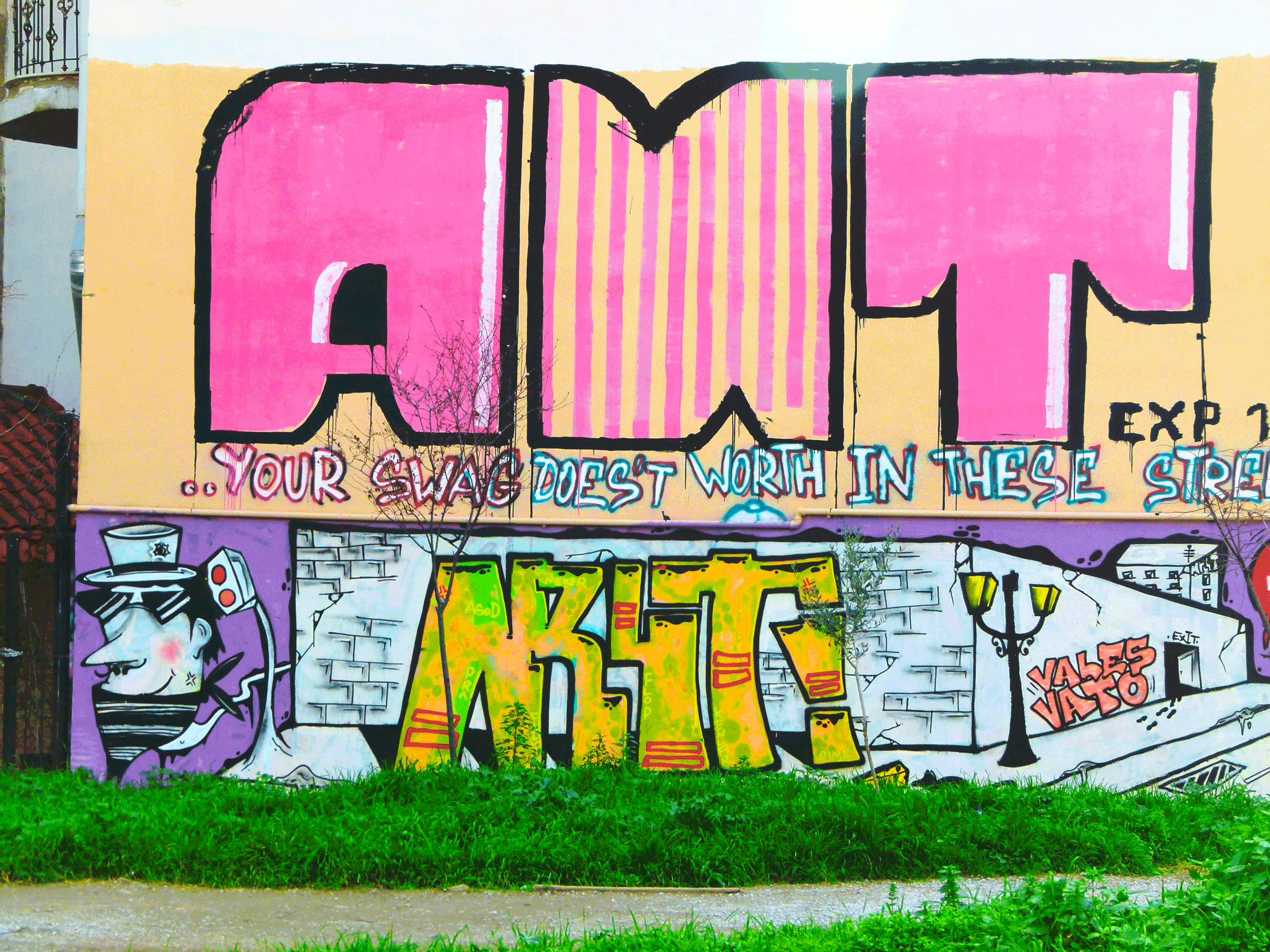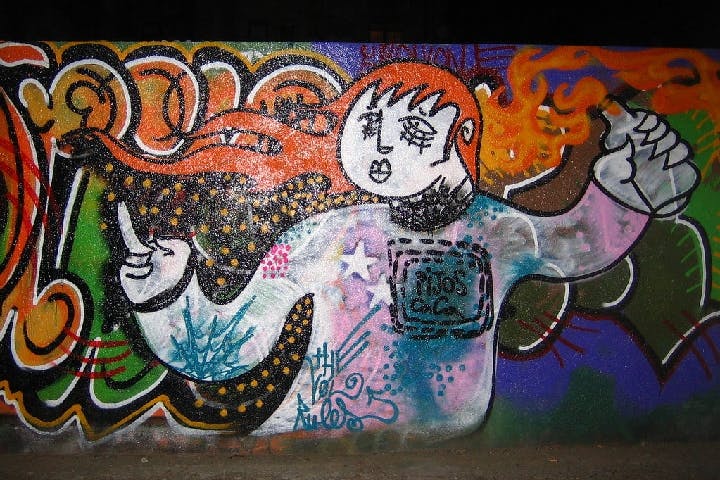Summer 2015
A Born-Again Faith in Graffiti
– Jonathan Gross
In 1970s New York, an age of austerity led to a rise in graffiti. So it is in Greece, 40 years later.
FOR FOUR MONTHS IN 2014, I taught at Greece’s Aristotle University in Thessaloniki, a school and community gripped by the austerity crisis. What I noticed first was the vibrancy of political protest, a foreign jolt to someone familiar with the political complacency of modern American college campuses. Greek students were alive with ideas. Gone was the sedate, American consumer model of education.
In March 2014, our campus became a staging ground for students canvassing ahead of the May elections. As the vote approached and my Fulbright lectureship ended, a student I came to know explained why all manner of political speech was sacrosanct on Greek college campuses (where tuition, incidentally, is free). In 1973, six years into Greece’s brutal military dictatorship, the campus of Athens Polytechnic saw a massive student demonstration against the junta, ending with bloodshed three days into the protests, when a tank crashed through the school’s front gates, soldiers entered, and civilians and students were killed (the exact number of fatalities is the subject of some dispute). November 17, the anniversary of the tragedy, is marked each year by Greece’s educational system: universities are closed, commemorations are held, and students are imbued with the sense that they are the spiritual heirs of those students, lest they take their rights for granted.
In Thessaloniki, the activist tendencies are most visible in the everyday reminders of unrest and clashing ideas: graffiti was everywhere. The building next to where I taught was a stunning yellow structure with a black anarchist sign defacing one of the walls. Large red banners streamed from cement blocks in a 1960s brutalist-style structure. Makeshift tables with books on Chairman Mao lined the hallways, and long-haired students reminiscent of Vietnam-era America emerged from classrooms like ghosts of my childhood. Surrounded by graffiti, I felt like a New York subway rider in 1974, when Norman Mailer published his essay “The Faith of Graffiti” in Esquire. “We are at the possible end of civilization,” he wrote, “and our instinct, battered, all polluted, dreams of some cleansing we have not found.”

Throughout the 1970s, New York City teetered on the brink of financial calamity. By October 1975, Mayor Abe Beame was readying an official bankruptcy declaration for America’s largest city. Days later, President Gerald Ford infamously nixed a federal bailout for the city, leading the New York Daily News to print one of the most famous front-pages in the history of American journalism: “FORD TO CITY: DROP DEAD” (never mind that Ford never actually used those words). In New York City’s age of austerity, arts programs in poorer schools were cut. Kids with an artistic bent — some aged 14 and under — painted in dark tunnels late into the night.
“Graffiti lingers on our subway doors as a memento of what it may well have been,” wrote Norman Mailer in 1974
Lee, Cope2, Tracy 168 — these self-designated writers became the Graffiti Kings of a new world. One of them, Taki 183, was Greek-American (his actual name is Demetrius), perhaps heralding the revolution I witnessed in Thessaloniki 40 years later. In the ‘70s, Taki, in the words of a 2011 New York Times profile, became a “shadowy folk hero … responsible for starting the modern graffiti movement,” stealthily scrawling his name onto subway poles and the mahogany entrances to posh apartment complexes on Manhattan's East Side. By the mid-1970s, graffiti went mainstream — “spray-can art,” to use a term popularized by Henry Chalfant, a classics major at Stanford whose photographs brought street art into the Museum of Contemporary Art and the Whitney, building on George Lee Quinones’ (Lee) success at the gallery Fashion MODA in 1980. In Training Days, Chalfant and Sacha Jenkins’s oral history of subway art, pioneering graffitist Lady Pink (a.k.a. Sandra Fabara) recalls that by 1982, spray-can art was being sold in SoHo boutiques. It was a leap many leading graffitists tried to make. Some became globetrotting, in-demand muralists, though this, to be sure, is a tamer art form: the work of mural painters earns money, not time at Riker’s Island. Murals are painted deliberately. Unlike graffiti, they are not illegal; the artist doesn’t risk going to prison. This shift was a shame, Jack Stewart argued in Graffiti Kings. Stewart, a former provost of the Rhode Island School of Design, contended that the thrill of the chase, the criminal nature of art, and the compressed timeframe of its production is what made graffiti so powerfully eloquent. Graffitists were, and are, uniquely artistic. Stewart understood, as Paul Simon once wrote, that “the words of the prophets are written on the subway walls.”

THE WORD “GRAFFITI,” the plural form of the Italian graffito, originates from the Greek γράφειν — graphein, meaning “to write.” Dating to catacombs in Pompeii, preserved as drawings in French caves, graffiti is the hand of man or woman, scrawling out an insistence: “I am here.” Artists the world over inscribe their names on monuments. Byron did it at Sounion and Delphi; Alexander at the Egyptian pyramids. Their signature is the “faith” of graffiti. Cope2 in the Bronx, Taki 183 in Washington Heights, and Cornbread in Philadelphia. They play with mutability by etching their name on a subway pillar or throwing up whole-car masterpieces that shuttle from Queens and Brooklyn to the Bronx and Staten Island.
Growing up, I’d ride into Manhattan from a Long Island suburb, watching graffiti-lacquered trains wend their way through Brooklyn, bearing the work of one of these artists, some anonymous king of the five boroughs. I had a friend, Tommy Swerdlow, who wrote in Central Park West during the “Son of Sam” days. He was a cool cat, Tommy Swerdlow. Like Cornbread in Philadelphia, he would have spray-painted an elephant if he could have gotten away with it. For an artist, it’s a self-advertisement: “I was … in love with my name," opens the graffiti documentary Bomb It, quoting Goethe’s Poetry and Truth (1811), “and … I wrote it everywhere."
In Thessaloniki, I noticed one mural that confused me. It seemed uncannily familiar. To begin with, there were no Greek letters. Its bubble letters and three-dimensional effects recalled the subway art of the 1970s, when I took the Long Island Rail Road for a regulated glimpse of urban grit. Then, too, what I saw in Thessaloniki in 2014 was not just graffiti, but something more patiently orchestrated. “Your Swag Does’t Worth In These Streets [sic],” read a mural, not in Greek, but in English. Every day, as I crossed the bridge to get to Aristotle University, I’d see a hieroglyphic near the mural: “AR4T!” It turned out to be an acronym for “Artists Republic 4 Tomorrow,” a studio and artists’ collective based in Laguna Beach, California, which professes an almost Shelleyan philosophy about the progressive aspects of art.

Aristotle University’s faculty wisely tolerated student protests, allowing graffiti to appear on walls. Young Greeks, for their part, have accepted their nation’s financial challenges with grace, rejecting violence. Over the last several years, Greeks have withstood humiliations great and small, from halts in garbage collection to the International Monetary Fund temporarily dictating the nation’s economic policy and political laws. True, three members of the ultra-right Golden Dawn were elected to the European parliament in 2014, but Greece is not goose-stepping its way out of austerity. The appeal of those aforementioned Shelleyan ideals might help explain the January 2015 election of Greece’s young leftist prime minister.
In November, when I presented my findings on graffiti at a conference in Athens entitled “The War on the Human,” most Greek students in attendance seemed nonplussed by my jejune lecture. Aristotle University’s graffiti, which so intrigued me, was to them nothing much — a shrug, an annoyance, an act of vandalism, but nothing more.
Their reaction was familiar: so graffiti had appeared to me when I was a young man living in Manhattan. At 52, I have come to think otherwise. I now admire the young people who spray-painted their way into history in the 1970s and 1980s, vandalizing streets, subways, and walls. I prefer their anarchic Manhattan to the moneyed Disneyland I see today when I visit New York as a tourist.
So it is in Thessaloniki, 40 years later. Young high school and college students, ignored by conventional careerist friends, express their rage about austerity and the ebbing prospects for their futures, mortgaged away by plutocrats.
“Graffiti lingers on our subway doors as a memento of what it may well have been,” Mailer wrote in 1974, “our first art of karma, as if indeed all the lives ever lived are sounding now like the bugles of gathering armies across the unseen ridge.”
* * *
Jonathan Gross is a professor of English at DePaul University in Chicago. He is the author of Graffiti Kings: a New Musical, (which debuted at Old Town School of Folk Music in April 2015), The Life of Anne Damer: Portrait of a Regency Artist, Byron: the Erotic Liberal, and edited Thomas Jefferson’s Scrapbooks: Poems of Nation, Family, and Romantic Love. He is currently working on a book titled Cure for the Common Core: Arts Integration in the Chicago Public Schools, funded by a Wicklander grant at DePaul.
Cover photo courtesy of Flickr/Owen Prior
